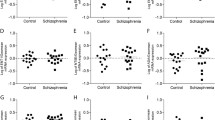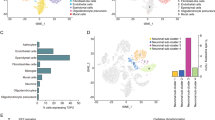Abstract
Recently developed methods for fluorescence-activated cell sorting (FACS) of freshly-isolated brain cells from transgenic mice combining fluorescent signals with cell type-specific markers allow cell-type separation. Based upon previous observations in primary cultures of mouse astrocytes we treated transgenic mice tagged with a neuron-specific or an astrocyte-specific marker with fluoxetine, either acute (10 mg/kg for 2 h) or chronic (10 mg/kg daily for 2 weeks). Acute treatment upregulated cfos and fosB mRNA expression in astrocytes and neurons. Chronic effects on astrocytes replicated those demonstrated in cultures, i.e., upregulation of mRNA and/or protein expression of 5-HT2B receptors (5-HT2BR), and GluK2 receptors, and of cPLA2a and ADAR2, together with increased GluK2 and 5-HT2BR editing. Neurons showed increased GluK4 and 5-HT2C receptor expression. To further correlate these findings with major depression we compared the changes in gene expression with those in a mouse model of anhedonia. Three out of 4 genes up-regulated in astrocytes by fluoxetine were down-regulated, whereas the neuronally upregulated 5-HT2C receptor gene showed no change. References are made to recent review papers discussing potential relations between observed fluoxetine effects and clinical effects of SSRIs, emphasizing that all 5 clinically used SSRIs have identical and virtually equipotent effects on cultured astrocytes.










Similar content being viewed by others
References
Bevilacqua L, Doly S, Kaprio J, Yuan Q, Tikkanen R, Paunio T, Zhou Z, Wedenoja J, Maroteaux L, Diaz S, Belmer A, Hodgkinson CA, Dell’osso L, Suvisaari J, Coccaro E, Rose RJ, Peltonen L, Virkkunen M, Goldman D (2010) A population-specific 5-HTR2B stop codon predisposes to severe impulsivity. Nature 468:1061–1066
Kim SJ, Veenstra-VanderWeele J, Hanna GL, Gonen D, Leventhal BL, Cook EH Jr (2000) Mutation screening of human 5-HT(2B)receptor gene in early-onset obsessive-compulsive disorder. Mol Cell Probes 14:47–52
Li B, Zhang S, Zhang H, Nu W, Cai L, Hertz L, Peng L (2008) Fluoxetine-mediated 5-HT2B receptor stimulation in astrocytes causes EGF receptor transactivation and ERK phosphorylation. Psychopharmacology 201:443–458
Li B, Zhang S, Li M, Hertz L, Peng L (2009) Chronic treatment of astrocytes with therapeutically relevant fluoxetine concentrations enhances cPLA2 expression secondary to 5-HT2B-induced, transactivation-mediated ERK1/2 phosphorylation. Psychopharmacology 207:1–12
Li B, Zhang S, Zhang H, Hertz L, Peng L (2011) Fluoxetine affects GluK2 editing, glutamate-evoked Ca(2+) influx and extracellular signal-regulated kinase phosphorylation in mouse astrocytes. J Psychiatry Neurosci 36:322–338
Englander MT, Dulawa SC, Bhansali P, Schmauss C (2005) How stress and fluoxetine modulate serotonin 2C receptor pre-mRNA editing. J Neurosci 25:648–651
Berg KA, Clarke WP, Cunningham KA, Spampinato U (2008) Fine-tuning serotonin2c receptor function in the brain: molecular and functional implications. Neuropharmacology 55:969–976
Barbon A, Orlandi C, La Via L, Caracciolo L, Tardito D, Musazzi L, Mallei A, Gennarelli M, Racagni G, Popoli M, Barlati S (2011) Antidepressant treatments change 5-HT2C receptor mRNA expression in rat prefrontal/frontal cortex and hippocampus. Neuropsychobiology 63:160–168
Pae CU, Yu HS, Lee KU, Kim JJ, Lee CU, Lee SJ, Jun TY, Lee C, Paik IH (2004) BanI polymorphism of the cytosolic phospholipase A2 gene may confer susceptibility to the development of schizophrenia. Prog Neuropsychopharmacol Biol Psychiatry 28:739–741
Rao JS, Ertley RN, Lee HJ, Rapoport SI, Bazinet RP (2006) Chronic fluoxetine upregulates activity, protein and mRNA levels of cytosolic phospholipase A2 in rat frontal cortex. Pharmacogenomics J 6:413–420
Su KP, Huang SY, Peng CY, Lai HC, Huang CL, Chen YC, Aitchison KJ, Pariante CM (2010) Phospholipase A2 and cyclooxygenase 2 genes influence the risk of interferon-alpha-induced depression by regulating polyunsaturated fatty acids levels. Biol Psychiatry 67:550–557
Delorme R, Krebs MO, Chabane N, Roy I, Millet B, Mouren-Simeoni MC, Maier W, Bourgeron T, Leboyer M (2004) Frequency and transmission of glutamate receptors GRIK2 and GRIK3 polymorphisms in patients with obsessive compulsive disorder. NeuroReport 15:699–702
Sampaio AS, Fagerness J, Crane J, Leboyer M, Delorme R, Pauls DL, Stewart SE (2011) Association between polymorphisms in GRIK2 gene and obsessive-compulsive disorder: a family-based study. CNS Neurosci Ther 17:141–147
Bass BL (2002) RNA editing by adenosine deaminases that act on RNA. Annu Rev Biochem 71:817–846
Kawahara Y, Ito K, Sun H, Ito M, Kanazawa I, Kwak S (2004) Regulation of glutamate receptor RNA editing and ADAR mRNA expression in developing human normal and Down’s syndrome brains. Dev Brain Res 148:151–155
Barbon A, Popoli M, La Via L, Moraschi S, Vallini I, Tardito D, Tiraboschi E, Musazzi L, Giambelli R, Gennarelli M, Racagni G, Barlati S (2006) Regulation of editing and expression of glutamate alpha-amino-propionic-acid (AMPA)/kainate receptors by antidepressant drugs. Biol Psychiatry 59:713–720
Kong EK, Peng L, Chen Y, Yu AC, Hertz L (2002) Up-regulation of 5-HT2B receptor density and receptor-mediated glycogenolysis in mouse astrocytes by long-term fluoxetine administration. Neurochem Res 27:113–120
Diaz SL, Doly S, Narboux-Nême N, Fernández S, Mazot P, Banas SM, Boutourlinsky K, Moutkine I, Belmer A, Roumier A, Maroteaux L (2012) 5-HT(2B) receptors are required for serotonin-selective antidepressant actions. Mol Psychiatry 17:154–163
Zhang S, Li B, Lovatt D, Xu J, Song D, Goldman SA, Nedergaard M, Hertz L, Peng L (2010) 5-HT2B receptors are expressed on astrocytes from brain and in culture and are a chronic target for all five conventional ‘serotonin-specific reuptake inhibitors’. Neuron Glia Biol 6:113–125
Einat H, Clenet F, Shaldubina A, Belmaker RH, Bourin M (2001) The antidepressant activity of inositol in the forced swim test involves 5-HT(2) receptors. Behav Brain Res 118:77–83
Peng LA, Juurlink BH, Hertz L (1991) Differences in transmitter release, morphology, and ischemia-induced cell injury between cerebellar granule cell cultures developing in the presence and in the absence of a depolarizing potassium concentration. Brain Res Dev Brain Res 63:1–12
Lovatt D, Sonnewald U, Waagepetersen HS, Schousboe A, He W, Lin JH, Han X, Takano T, Wang S, Sim FJ, Goldman SA, Nedergaard M (2007) The transcriptome and metabolic gene signature of protoplasmic astrocytes in the adult murine cortex. J Neurosci 27:12255–12266
Stein EJ, da Silveira Filho NG, Machado DC, Hipólide DC, Barlow K, Nobrega JN (2009) Chronic mild stress induces widespread decreases in thyroid hormone alpha1 receptor mRNA levels in brain–reversal by imipramine. Psychoneuroendocrinology 34:281–286
Knapman A, Heinzmann JM, Holsboer F, Landgraf R, Touma C (2010) Modeling psychotic and cognitive symptoms of affective disorders: disrupted latent inhibition and reversal learning deficits in highly stress reactive mice. Neurobiol Learn Mem 94:145–152
Feng G, Mellor RH, Bernstein M, Keller-Peck C, Nguyen QT, Wallace M, Nerbonne JM, Lichtman JW, Sanes JR (2000) Imaging neuronal subsets in transgenic mice expressing multiple spectral variants of GFP. Neuron 28:41–51
Seki M, Nawa H, Morioka T, Fukuchi T, Oite T, Abe H, Takei N (2002) Establishment of a novel enzyme-linked immunosorbent assay for Thy-1; quantitative assessment of neuronal degeneration. Neurosci Lett 329:185–188
Jaggi AS, Bhatia N, Kumar N, Singh N, Anand P, Dhawan R (2011) A review on animal models for screening potential anti-stress agents. Neurol Sci 32:993–1005
Fu H, Li B, Hertz L, Peng L (2012) Contributions in astrocytes of SMIT1/2 and HMIT to myo-inositol uptake at different concentrations and pH. Neurochem Int. http://dx.doi.org/10.1016/j.neuint.2012.04.010
Iwamoto K, Bundo M, Kato T (2005) Estimating RNA editing efficiency of five editing sites in the serotonin 2C receptor by pyrosequencing. RNA 11:1596–1603
Baez M, Kursar JD, Helton LA, Wainscott DB, Nelson DL (1995) Molecular biology of serotonin receptors. Obes Res Suppl 4:441S–447S
Mombereau C, Kawahara Y, Gundersen BB, Nishikura K, Blendy JA (2010) Functional relevance of serotonin 2C receptor mRNA editing in antidepressant- and anxiety-like behaviors. Neuropharmacology 59:468–473
Hertz L, Li B, Song D, Ren J, Dong L, Chen Y, Peng L (2012) Astrocytes as a 5-HT2B-mediated SSRI, SERT-independent target, slowly altering depression-associated genes and function. Curr Signal Transd T 7:65–80
Peng L, Li B, Du T, Wang F, Hertz L (2012) Does conventional anti-bipolar and antidepressant drug therapy reduce NMDA-mediated neuronal excitation by downregulating astrocytic GluK2 function? Pharmacol Biochem Behav 100:712–725
Frazer A (2001) Serotonergic and noradrenergic reuptake inhibitors: prediction of clinical effects from in vitro potencies. J Clin Psychiatry Suppl 12:16–23
Bernard R, Kerman IA, Thompson RC, Jones EG, Bunney WE, Barchas JD, Schatzberg AF, Myers RM, Akil H, Watson SJ (2011) Altered expression of glutamate signaling, growth factor, and glia genes in the locus coeruleus of patients with major depression. Mol Psychiatry 16:634–646
Bekar LK, He W, Nedergaard M (2008) Locus coeruleus alpha-adrenergic-mediated activation of cortical astrocytes in vivo. Cereb Cortex 18:2789–2795
Perry KW, Fuller RW (1992) Effect of fluoxetine on serotonin and dopamine concentration in microdialysis fluid from rat striatum. Life Sci 50:1683–1690
Li BM, Zhang SQ, Zhang HY, Hertz L, Peng L (2011) Fluoxetine affects GluK2 editing, glutamate-evoked Ca(2+) influx and extracellular signal-regulated kinase phosphorylation in mouse astrocytes. J Psychiatry Neurosci 36:322–338
Catches JS, Xu J, Contractor A (2012) Genetic ablation of the GluK4 kainate receptor subunit causes anxiolytic and antidepressant-like behavior in mice. Behav Brain Res 228:406–414
Paddock S, Laje G, Charney D, Rush AJ, Wilson AF, Sorant AJ, Lipsky R, Wisniewski SR, Manji H, McMahon FJ (2007) Association of GRIK4 with outcome of antidepressant treatment in the STAR*D cohort. Am J Psychiatry 164:1181–1188
Chowdhury GM, Behar KL, Cho W, Thomas MA, Rothman DL, Sanacora G (2012) (1)H-[(13)C]-Nuclear magnetic resonance spectroscopy measures of ketamine’s effect on amino acid neurotransmitter metabolism. Biol Psychiatry 71:1022–1025
Bureau I, Dieudonne S, Coussen F, Mulle C (2000) Kainate receptor-mediated synaptic currents in cerebellar Golgi cells are not shaped by diffusion of glutamate. Proc Natl Acad Sci USA 97:6838–6843
Li B, Zhang S, Zhang H, Hertz L, Peng L (2011) Fluoxetine affects GluK2 editing, glutamate-evoked Ca(2+) influx and extracellular signal-regulated kinase phosphorylation in mouse astrocytes. J Psychiatry Neurosci 36:322–338
Hong J, Qian Z, Shen S, Min T, Tan C, Xu J, Zhao Y, Huang W (2005) High doses of siRNAs induce eri-1 and adar-1 gene expression and reduce the efficiency of RNA interference in the mouse. Biochem J 390:675–679
Feng Y, Sansam CL, Singh M, Emeson RB (2006) Altered RNA editing in mice lacking ADAR2 autoregulation. Mol Cell Biol 26:480–488
Ivanov AI, Pero RS, Scheck AC, Romanovsky AA (2002) Prostaglandin E(2)-synthesizing enzymes in fever: differential transcriptional regulation. Am J Physiol Regul Integr Comp Physiol 283:R1104–R1117
Lindbom J, Ljungman AG, Lindahl M, Tagesson C (2001) Expression of members of the phospholipase A2 family of enzymes in human nasal mucosa. Eur Respir J 18:130–138
Kennedy BP, Payette P, Mudgett J, Vadas P, Pruzanski W, Kwan M, Tang C, Rancourt DE, Cromlish WA (1995) A natural disruption of the secretory group II phospholipase A2 gene in inbred mouse strains. J Biol Chem 270:22378–22385
Choi DS, Ward SJ, Messadeqq N, Launay JM, Maroteaux L (1997) 5-HT2B receptor-mediated serotonin morphogenetic functions in mouse cranial neural crest and myocardiac cells. Development 124:1745–1755
Li B, Zhang S, Zhang H, Hertz L, Peng L (2011) Fluoxetine affects GluK2 editing, glutamate-evoked Ca(2+) influx and extracellular signal-regulated kinase phosphorylation in mouse astrocytes. J Psychiatry Neurosci 36:322–338
Popova NK, Naumenko VS, Tibeikina MA, Kulikov AV (2009) Serotonin transporter, 5-HT1A receptor, and behavior in DBA/2 J mice in comparison with four inbred mouse strains. J Neurosci Res 87:3649–3657
Elkeles A, Juven-Gershon T, Israeli D, Wilder S, Zalcenstein A, Oren M (1999) The c-fos proto-oncogene is a target for transactivation by the p53 tumor suppressor. Mol Cell Biol 19:2594–2600
Inoue D, Kido S, Matsumoto T (2004) Transcriptional induction of FosB/DeltaFosB gene by mechanical stress in osteoblasts. J Biol Chem 279:49795–49803
El-Marjou M, Montalescot V, Buzyn A, Geny B (2000) Modifications in phospholipase D activity and isoform expression occur upon maturation and differentiation in vivo and in vitro in human myeloid cells. Leukemia 14:2118–2127
Acknowledgments
This study was supported by Grants No. 31000479 to BL and No. 30770667 and 31171036 to LP from the National Natural Science Foundation of China.
Conflict of interest
The authors report no conflicts of interest.
Author information
Authors and Affiliations
Corresponding author
Additional information
In Honor of Leif Hertz
Electronic supplementary material
Below is the link to the electronic supplementary material.
Rights and permissions
About this article
Cite this article
Li, B., Dong, L., Wang, B. et al. Cell Type-Specific Gene Expression and Editing Responses to Chronic Fluoxetine Treatment in the In Vivo Mouse Brain and Their Relevance for Stress-Induced Anhedonia. Neurochem Res 37, 2480–2495 (2012). https://doi.org/10.1007/s11064-012-0814-1
Received:
Revised:
Accepted:
Published:
Issue Date:
DOI: https://doi.org/10.1007/s11064-012-0814-1




